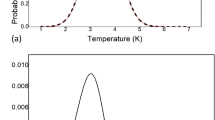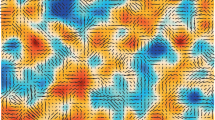Abstract
THE discovery of microwave background radiation by Penzias and Wilson1 is one of the most interesting events in observational astronomy in recent years. On the basis of the first observations at a single wavelength, the radiation was interpreted2 as being of the black-body type, and it was concluded that this was the remnant of the primordial radiation of a big-bang universe. Later results by different observers have strengthened this interpretation. Indeed it is now claimed3,4 that the black-body curve applies for a wavelength range of 1 : 90, and corresponds to a temperature T = 2.68° K. The observers5 go as far as to state that the exact black-body intensity curve  fits the observations better than the “grey-body” approximation at long wavelengths—namely
fits the observations better than the “grey-body” approximation at long wavelengths—namely 
This is a preview of subscription content, access via your institution
Access options
Subscribe to this journal
Receive 51 print issues and online access
$199.00 per year
only $3.90 per issue
Buy this article
- Purchase on Springer Link
- Instant access to full article PDF
Prices may be subject to local taxes which are calculated during checkout
Similar content being viewed by others
References
Penzias, A. A., and Wilson, R. W., Astrophys. J., 142, 319 (1965).
Dicke, R. H., Peebles, P. J. E., Roll, P. G., and Wilkinson, D. T., Astrophys. J., 142, 414 (1965).
Howell, T. F., and Shakeshaft, J. R., Nature, 216, 753 (1967).
Shakeshaft, J. R., and Webster, A. S., Nature, 217, 339 (1968).
Stokes, R. A., Partridge, R. B., and Wilkinson, D. T., Phys. Rev. Lett., 19, 1199 (1967).
Hoyle, F., and Wickramasinghe, N. C., Nature, 214, 969 (1967).
Narlikar, J. V., and Wickramasinghe, N. C., Nature, 216, 43 (1967).
Longair, M. S., Nature, 211, 949 (1966).
Davidson, W., and Davies, M., Mon. Not. Roy. Astro. Soc., 127, 241 (1964).
Davidson, W., and Narlikar, J. V., Rep. Prog. Phys., 29, 539 (1966).
Partridge, R. B., and Wilkinson, D. T., Nature, 215, 719 (1967).
Kurilchik, V. N., and Kokin, Yu. F., Soviet Astron., 11, 374 (1967).
Low, F. J., Tucson Conference on Seyfert Galaxies, February, 1968.
Author information
Authors and Affiliations
Rights and permissions
About this article
Cite this article
NARLIKAR, J., WICKRAMASINGHE, N. Interpretation of Cosmic Microwave Background. Nature 217, 1235–1236 (1968). https://doi.org/10.1038/2171235a0
Received:
Issue Date:
DOI: https://doi.org/10.1038/2171235a0
This article is cited by
-
Absorption effects of intergalactic natural graphite whiskers on observations at microwave and radio frequencies
Astrophysics and Space Science (1979)
-
Interpretation of observed cosmic microwave background radiation
Nature (1977)
-
Discrete source counts and the rotation of the local Universe in hierarchical cosmology
Astrophysics and Space Science (1975)
-
A dust model for the cosmic microwave background
Astrophysics and Space Science (1975)
Comments
By submitting a comment you agree to abide by our Terms and Community Guidelines. If you find something abusive or that does not comply with our terms or guidelines please flag it as inappropriate.



